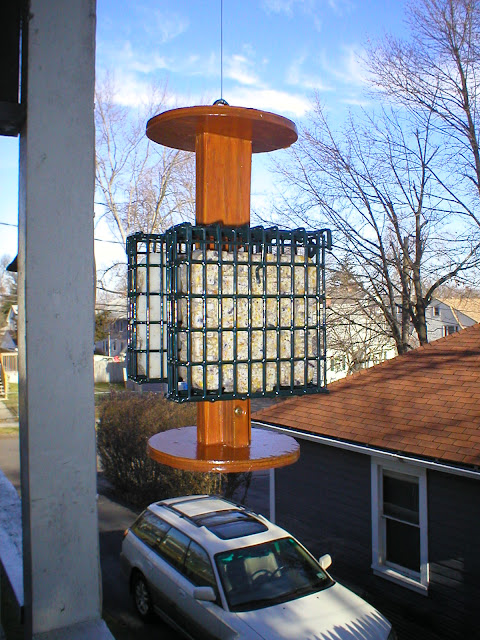As part of our ongoing effort to do something this winter beside working on the boat, we decided to design and build a bird feeder. This little beauty, which we have designated "Improved Bird Feeder, Model One," was assembled from scrap wood and the very last bit of Sikkens Cetol that we had left over from our swim platform rehab project. Obviously, the cages that hold the suet in place were purchased but they are held in place with stainless screws and fender washers that would be at home on any boat
Here's another shot, showing the superior workmanship and design including a circular rain roof and bottom feeding platform. Luckily we had an old coffee can on hand to serve as a pattern for them.
After hanging this thing up, we had hoped to see a flock of Downy Woodpeckers enjoying that delicious suet but in the two days it has been up, we haven't been able to detect any peckerage. We now think that may be because the little peckers can probably still smell the Sikkens. Well, that's what we hope, anyway. We'll keep a proper lookout on this thing to see what, if anything, it attracts.
Meanwhile, back on the boat...
If you've read our recent blog posts, you'll remember that we're on a mission to clean up the wiring at our lower helm. Last weekend, we managed to separate the 12 volt positive wiring for the port and starboard sides. Much of two two circuits had been wired together for some reason, which resulted in odd and inconsistent engine gauge readings. Last weekend, we pulled all of that positive wiring apart and wired each circuit to a new terminal strip. Here's an example of one of the splices that we cut out. Crap like this, wrapped in old electrical tape and pushed back out of the way, would probably void our insurance if there should ever be a serious electrical incident. This one was 14-gauge wire, wrapped together and then soldered, although the solder connection was cold, meaning that it wasn't holding anything together.
This weekend, we attacked the ground circuits. By design, there are no separate port and starboard ground systems since both negative battery banks are wired together through the engines. But all the current drawn by every DC circuit on the boat returns through those grounds, so they are important.
What we found here probably can't be blamed on the previous owner. This looked like original Silverton wiring. All of the ground connections were connected together at a large bolt that also held a big cable clamp in place. Here's a picture of what that looked like.
There were nine separate ground connections made at the bolt you can see just to the left of blue hydraulic steering line. When we began inspecting them, we found that they weren't even tight.
Our solution was to install another terminal strip that combined all of the small and large ground connections on one ground buss. We ganged the terminal strip at home with 12-gauge wire and then, once on the boat, pulled everything apart at the helm and reconnected all of those grounds properly.
We have no way to test what these repairs actually accomplished except that the lower helm voltmeters now accurately read the true battery bank voltages, which they never did before. Obviously, we can't start the engines to do a real test because we are out of the water.
We have one more effort before we move on from the electrical system. We're going to run dedicated (8-gauge) cables from the two battery banks directly to the upper and lower helms. The lower helm probably doesn't need this additional electrical capacity but the bridge certainly does, where we have radar, a chartplotter, an air horn and a VHF marine radio.
Pulling cables through this boat in the dead of winter won't be fun but what's the alternative? Building bird feeders?





No comments:
Post a Comment